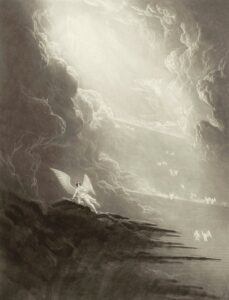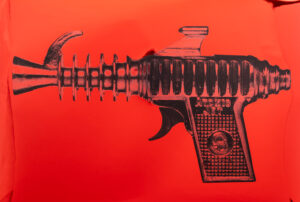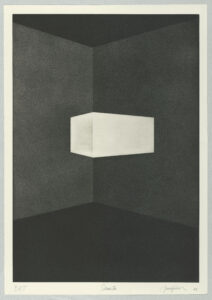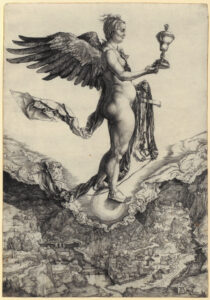Constant movement and ever-changing form are of the essence of clouds. Their mobility and variety make them impossible to pin down—yet by the same token, clouds can be anything: from the sublime embodiment of longing and an ominous portent, to the dwelling of the gods, to a mere accumulation of condensed water.
But if the essence of clouds consists in their perpetual motion and formal metamorphosis, how can they be captured in an image? Is a cloud on paper or canvas inherently a trapped or even dead cloud? The works in the exhibition show how clouds can survive this change of location from sky to paper, and even flourish—if the cloud-catcher understands his craft. For each of the many techniques of printmaking is uniquely suited to pay homage to a different aspect of clouds and thus invites intentional use.
The power of clouds to inspire enthusiasm for science in the realm of the arts has been celebrated ever since Johann Wolfgang von Goethe composed poetry in response to the categorization of clouds by meteorologist Luke Howard. And isn’t Howard’s own poetic sense reflected in the names he chose to describe the clouds—cirrus, cumulus, and stratus, which in Latin mean “lock of hair,” “heap,” and “outspread blanket”?
Clouds and their inspiring potential for synthesis are the focus of the exhibition. The perspective of artists from seven centuries—including Lucas van Leyden, Lorenzo Tiepolo, and Meret Oppenheim—is complemented by works from the inexhaustible holdings of the Image Archive of the ETH Library, here represented above all by the photography of the scientists and expeditioners Arnold Heim and Walter Mittelholzer.
Curated by Susanne Pollack (Graphische Sammlung ETH Zürich) and Nicole Graf (Image Archive, ETH Library)

John Martin, Satan Viewing the Ascent to Heaven, illustration from John Milton’s Paradise Lost, 1825, mezzotint, 372 x 271 mm, Graphische Sammlung ETH Zürich, Inv.-Nr. D 38526
Not every depiction of the iconic scene of Adam and Eve is “innocent”. Every Judith triumphs over Holofernes in a different way. There are many versions of the “femmes fatales” in the collection of the Graphische Sammlung: Naked women squatting on the heads of severed male heads, ladies with oversized hair sculptures and Mercedes stars instead of nipples. The planned exhibition will focus on eye-catching gestures and poses from the chatoyant course of art history, as well as on an excessive display of banal objects that are both grandiose and bizarre.
Together with cultural critic Elisabeth Bronfen, we went through the holdings of the Graphische Sammlung to explore the extent to which “fetishism”, with its complex conceptual history, has promoted the construction of what is considered to be “familiar” in contrast to what is conceived as being “unfamiliar, strange and illicit”.
The exhibition will explore a wide variety of fetishistic mechanisms in the arts from the Middle Ages through Romanticism to the present day. In an effort to map the way these entail different encodings of gender and engender ever new forms of allegory, works by artists such as Barthel Beham, Wenzel Hollar, Johann Heinrich Füssli or Max Klinger will be placed in dialog with works by Urs Lüthi, Robert Gober and Sylvie Fleury.
Curated by Alexandra Barcal (Graphische Sammlung ETH Zürich) and Prof Dr Elisabeth Bronfen (cultural and literary scholar and former professor of English at the University of Zurich)

Sylvie Fleury
Untitled from Rayguns, 2004
Silkscreen Screen print on Mirri paper
50.0 x 69.8 cm Inv.-Nr. 2011.0121.04
Graphische Sammlung ETH Zürich / © Sylvie Fleury
James Turrell (born 1943 in Los Angeles) is undoubtedly one of the most important artists of our time. Some time ago, the Children’s Hospital Zurich installed his light room “My Light” in a pavilion, where patients, relatives and staff find peace and comfort. A large Turrell installation entitled “My Sky” is now planned for their new building, which will be completed in 2024. The Graphische Sammlung ETH Zurich is taking this as an opportunity to present its rich collection of prints by the artist in an exhibition.
James Turrell created his first ever prints in 1984. Inspired by the publisher Peter Blum, he found the ideal partner in the Zurich copperplate printer Peter Kneubühler. Since 2008, the Graphische Sammlung ETH Zürich has owned over 150 prints by James Turrell from the estate of the Peter Kneubühler Foundation, including proofs and various states. They are at the centre of the presentation.
Today, Turrell’s works are of interest not least because they are situated at the interface of various disciplines, including the natural sciences. There are points of contact with architecture, land art, astronomy, aerospace, physics, earth sciences, medicine, perceptual psychology and mysticism. If an exhibition is now planned in the Graphische Sammlung ETH Zürich, this multi-perspectivity on his work will be the focus enabling a new, sometimes unexpected view of his work. At the same time, such aspects will be discussed in depth at an international scientific conference taking place in fall 2024.
The results of the congress are planned to be published in a comprehensive conference volume with well-founded text contributions.
Curated by Dr Linda Schädler, Head Graphische Sammlung ETH Zürich

James Turrell (*1943)
Shanta, sheet from the series First Light, 1989
aquatint
108 x 76 cm
inv. no. 2008.1472.2
Graphische Sammlung ETH Zürich / © ProLitteris, Zürich 2023
If you close your eyes and think of Albrecht Dürer (1471-1528), you will see something. Be it his self-portrait from 1500, in which he dared to stage himself in an iconic and Christ-like manner, be it the watercolour lawn piece with which he elevated the ground beneath our feet to eye level, or be it his omnipresent copperplate engraving of the naked primal parents, in which he summarised his studies on the proportions of the human body and at the same time proved that artists like him do not need colours to surpass nature itself.
Whether an artist’s influence extends beyond the circles of an elite art-loving public is measured by whether he or she is also encountered outside of well-tempered museum spaces. Reproductions of Albrecht Dürer’s pictorial creations have conquered just about every conceivable place: from school textbooks to grandparents’ bedrooms or, most recently, public swimming pools, as his “Praying Hands” or the enigmatic “Melancholia” are now part of the standard repertoire of every tattoo studio.
The Graphische Sammlung ETH Zürich not only owns Albrecht Dürer’s graphic work almost in their entirety, but also in enviable quality, including examples of his rare iron etchings and drypoint works. The selection of works for the exhibition will focus on emphasising Dürer’s relevance to current art discourses and honouring him as an artist who, above all in his prints, succeeded not only in breaking norms but also in setting standards.
Curated by Dr Susanne Pollack, Graphische Sammlung ETH Zürich

Albrecht Dürer (1471-1528)
Nemesis
Engraving
33.1 x 23 cm inv. no. D 807 Graphische Sammlung ETH Zürich